Analyzing Educational Reforms Using New Institutional Theory
VerifiedAdded on 2023/06/04
|6
|1382
|308
Essay
AI Summary
This essay explores the application of New Institutional Theory (NIT) to understand the complexities of educational reforms. It addresses Labaree's perspective on why reformers struggle to achieve their goals, attributing it to the multi-layered nature of educational systems and the challenges of large-scale transformation. The essay then examines how NIT concepts, such as loose coupling, isomorphism, and ceremonial compliance, manifest in specific education reform areas like anti-bullying initiatives within the K-12 system. It further discusses the connection between universities and the knowledge-based economy through the lens of NIT, highlighting the presence of loose coupling and bureaucratic elements in modern universities. Finally, the essay considers the impact of accountability and equity pressures on schools since the formulation of NIT, suggesting that schools are often more oriented toward seeking legitimacy than achieving efficiency due to isomorphic tendencies and a focus on formal processes.
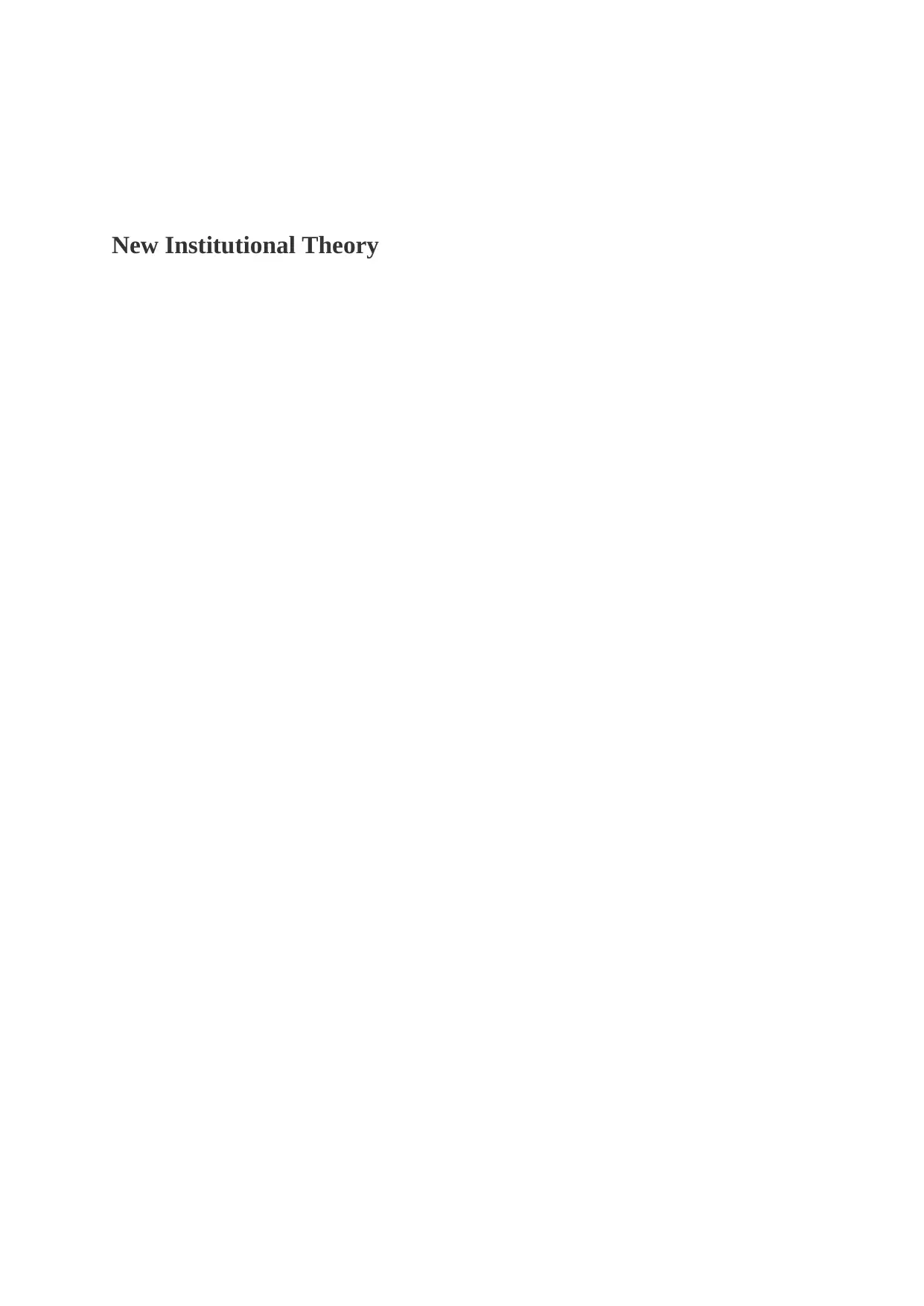
New Institutional Theory
Paraphrase This Document
Need a fresh take? Get an instant paraphrase of this document with our AI Paraphraser
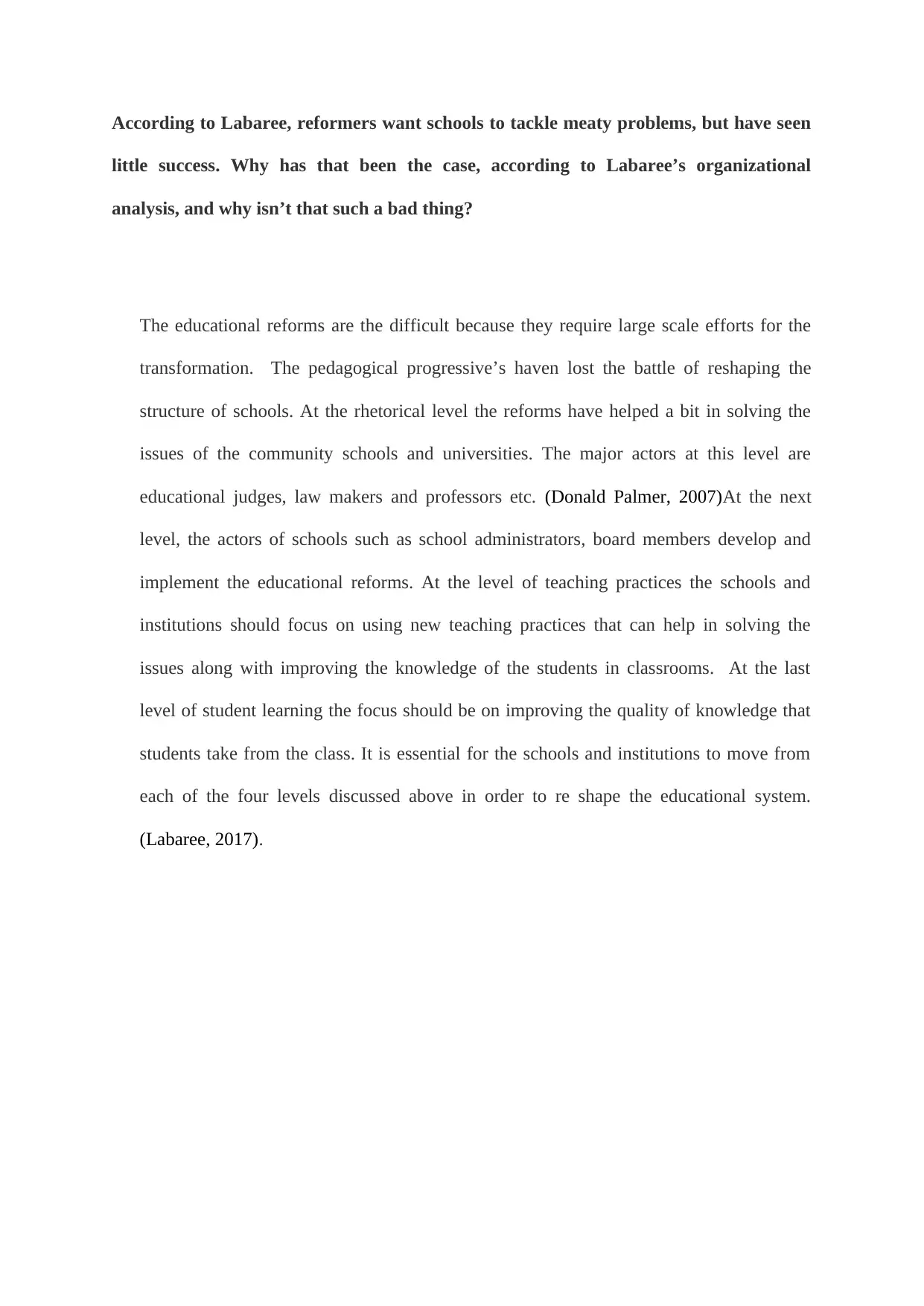
According to Labaree, reformers want schools to tackle meaty problems, but have seen
little success. Why has that been the case, according to Labaree’s organizational
analysis, and why isn’t that such a bad thing?
The educational reforms are the difficult because they require large scale efforts for the
transformation. The pedagogical progressive’s haven lost the battle of reshaping the
structure of schools. At the rhetorical level the reforms have helped a bit in solving the
issues of the community schools and universities. The major actors at this level are
educational judges, law makers and professors etc. (Donald Palmer, 2007)At the next
level, the actors of schools such as school administrators, board members develop and
implement the educational reforms. At the level of teaching practices the schools and
institutions should focus on using new teaching practices that can help in solving the
issues along with improving the knowledge of the students in classrooms. At the last
level of student learning the focus should be on improving the quality of knowledge that
students take from the class. It is essential for the schools and institutions to move from
each of the four levels discussed above in order to re shape the educational system.
(Labaree, 2017).
little success. Why has that been the case, according to Labaree’s organizational
analysis, and why isn’t that such a bad thing?
The educational reforms are the difficult because they require large scale efforts for the
transformation. The pedagogical progressive’s haven lost the battle of reshaping the
structure of schools. At the rhetorical level the reforms have helped a bit in solving the
issues of the community schools and universities. The major actors at this level are
educational judges, law makers and professors etc. (Donald Palmer, 2007)At the next
level, the actors of schools such as school administrators, board members develop and
implement the educational reforms. At the level of teaching practices the schools and
institutions should focus on using new teaching practices that can help in solving the
issues along with improving the knowledge of the students in classrooms. At the last
level of student learning the focus should be on improving the quality of knowledge that
students take from the class. It is essential for the schools and institutions to move from
each of the four levels discussed above in order to re shape the educational system.
(Labaree, 2017).
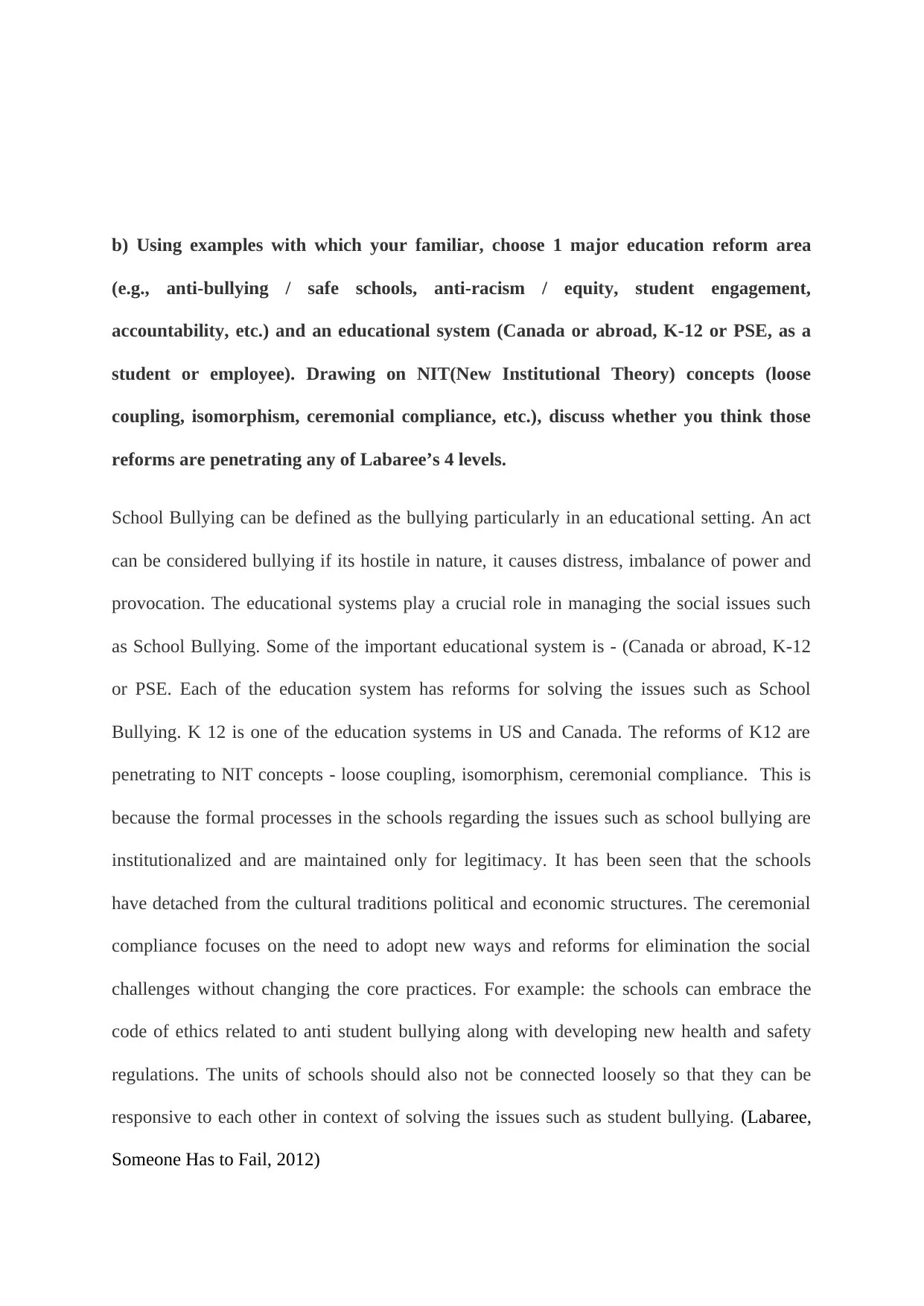
b) Using examples with which your familiar, choose 1 major education reform area
(e.g., anti-bullying / safe schools, anti-racism / equity, student engagement,
accountability, etc.) and an educational system (Canada or abroad, K-12 or PSE, as a
student or employee). Drawing on NIT(New Institutional Theory) concepts (loose
coupling, isomorphism, ceremonial compliance, etc.), discuss whether you think those
reforms are penetrating any of Labaree’s 4 levels.
School Bullying can be defined as the bullying particularly in an educational setting. An act
can be considered bullying if its hostile in nature, it causes distress, imbalance of power and
provocation. The educational systems play a crucial role in managing the social issues such
as School Bullying. Some of the important educational system is - (Canada or abroad, K-12
or PSE. Each of the education system has reforms for solving the issues such as School
Bullying. K 12 is one of the education systems in US and Canada. The reforms of K12 are
penetrating to NIT concepts - loose coupling, isomorphism, ceremonial compliance. This is
because the formal processes in the schools regarding the issues such as school bullying are
institutionalized and are maintained only for legitimacy. It has been seen that the schools
have detached from the cultural traditions political and economic structures. The ceremonial
compliance focuses on the need to adopt new ways and reforms for elimination the social
challenges without changing the core practices. For example: the schools can embrace the
code of ethics related to anti student bullying along with developing new health and safety
regulations. The units of schools should also not be connected loosely so that they can be
responsive to each other in context of solving the issues such as student bullying. (Labaree,
Someone Has to Fail, 2012)
(e.g., anti-bullying / safe schools, anti-racism / equity, student engagement,
accountability, etc.) and an educational system (Canada or abroad, K-12 or PSE, as a
student or employee). Drawing on NIT(New Institutional Theory) concepts (loose
coupling, isomorphism, ceremonial compliance, etc.), discuss whether you think those
reforms are penetrating any of Labaree’s 4 levels.
School Bullying can be defined as the bullying particularly in an educational setting. An act
can be considered bullying if its hostile in nature, it causes distress, imbalance of power and
provocation. The educational systems play a crucial role in managing the social issues such
as School Bullying. Some of the important educational system is - (Canada or abroad, K-12
or PSE. Each of the education system has reforms for solving the issues such as School
Bullying. K 12 is one of the education systems in US and Canada. The reforms of K12 are
penetrating to NIT concepts - loose coupling, isomorphism, ceremonial compliance. This is
because the formal processes in the schools regarding the issues such as school bullying are
institutionalized and are maintained only for legitimacy. It has been seen that the schools
have detached from the cultural traditions political and economic structures. The ceremonial
compliance focuses on the need to adopt new ways and reforms for elimination the social
challenges without changing the core practices. For example: the schools can embrace the
code of ethics related to anti student bullying along with developing new health and safety
regulations. The units of schools should also not be connected loosely so that they can be
responsive to each other in context of solving the issues such as student bullying. (Labaree,
Someone Has to Fail, 2012)
⊘ This is a preview!⊘
Do you want full access?
Subscribe today to unlock all pages.

Trusted by 1+ million students worldwide
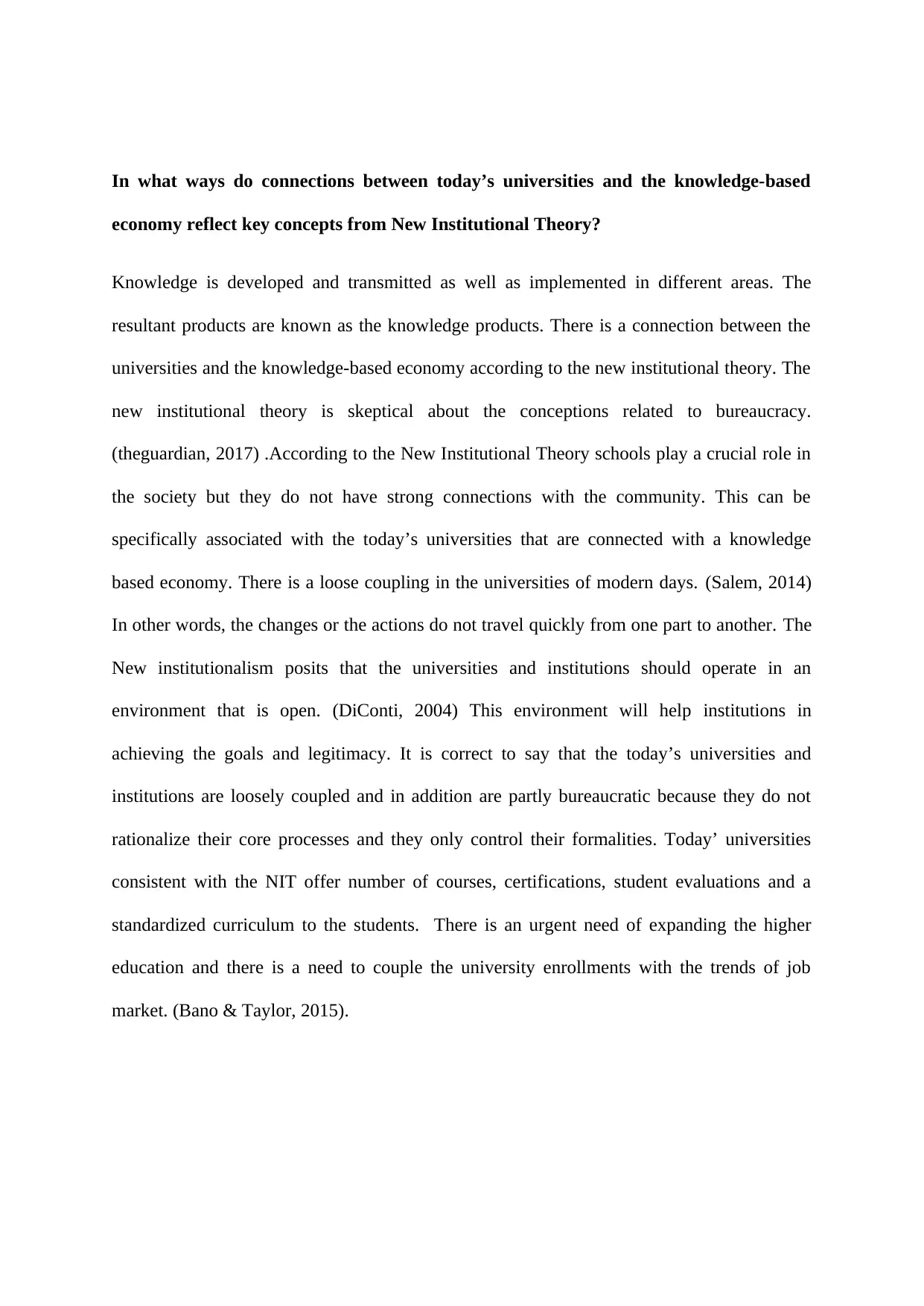
In what ways do connections between today’s universities and the knowledge-based
economy reflect key concepts from New Institutional Theory?
Knowledge is developed and transmitted as well as implemented in different areas. The
resultant products are known as the knowledge products. There is a connection between the
universities and the knowledge-based economy according to the new institutional theory. The
new institutional theory is skeptical about the conceptions related to bureaucracy.
(theguardian, 2017) .According to the New Institutional Theory schools play a crucial role in
the society but they do not have strong connections with the community. This can be
specifically associated with the today’s universities that are connected with a knowledge
based economy. There is a loose coupling in the universities of modern days. (Salem, 2014)
In other words, the changes or the actions do not travel quickly from one part to another. The
New institutionalism posits that the universities and institutions should operate in an
environment that is open. (DiConti, 2004) This environment will help institutions in
achieving the goals and legitimacy. It is correct to say that the today’s universities and
institutions are loosely coupled and in addition are partly bureaucratic because they do not
rationalize their core processes and they only control their formalities. Today’ universities
consistent with the NIT offer number of courses, certifications, student evaluations and a
standardized curriculum to the students. There is an urgent need of expanding the higher
education and there is a need to couple the university enrollments with the trends of job
market. (Bano & Taylor, 2015).
economy reflect key concepts from New Institutional Theory?
Knowledge is developed and transmitted as well as implemented in different areas. The
resultant products are known as the knowledge products. There is a connection between the
universities and the knowledge-based economy according to the new institutional theory. The
new institutional theory is skeptical about the conceptions related to bureaucracy.
(theguardian, 2017) .According to the New Institutional Theory schools play a crucial role in
the society but they do not have strong connections with the community. This can be
specifically associated with the today’s universities that are connected with a knowledge
based economy. There is a loose coupling in the universities of modern days. (Salem, 2014)
In other words, the changes or the actions do not travel quickly from one part to another. The
New institutionalism posits that the universities and institutions should operate in an
environment that is open. (DiConti, 2004) This environment will help institutions in
achieving the goals and legitimacy. It is correct to say that the today’s universities and
institutions are loosely coupled and in addition are partly bureaucratic because they do not
rationalize their core processes and they only control their formalities. Today’ universities
consistent with the NIT offer number of courses, certifications, student evaluations and a
standardized curriculum to the students. There is an urgent need of expanding the higher
education and there is a need to couple the university enrollments with the trends of job
market. (Bano & Taylor, 2015).
Paraphrase This Document
Need a fresh take? Get an instant paraphrase of this document with our AI Paraphraser
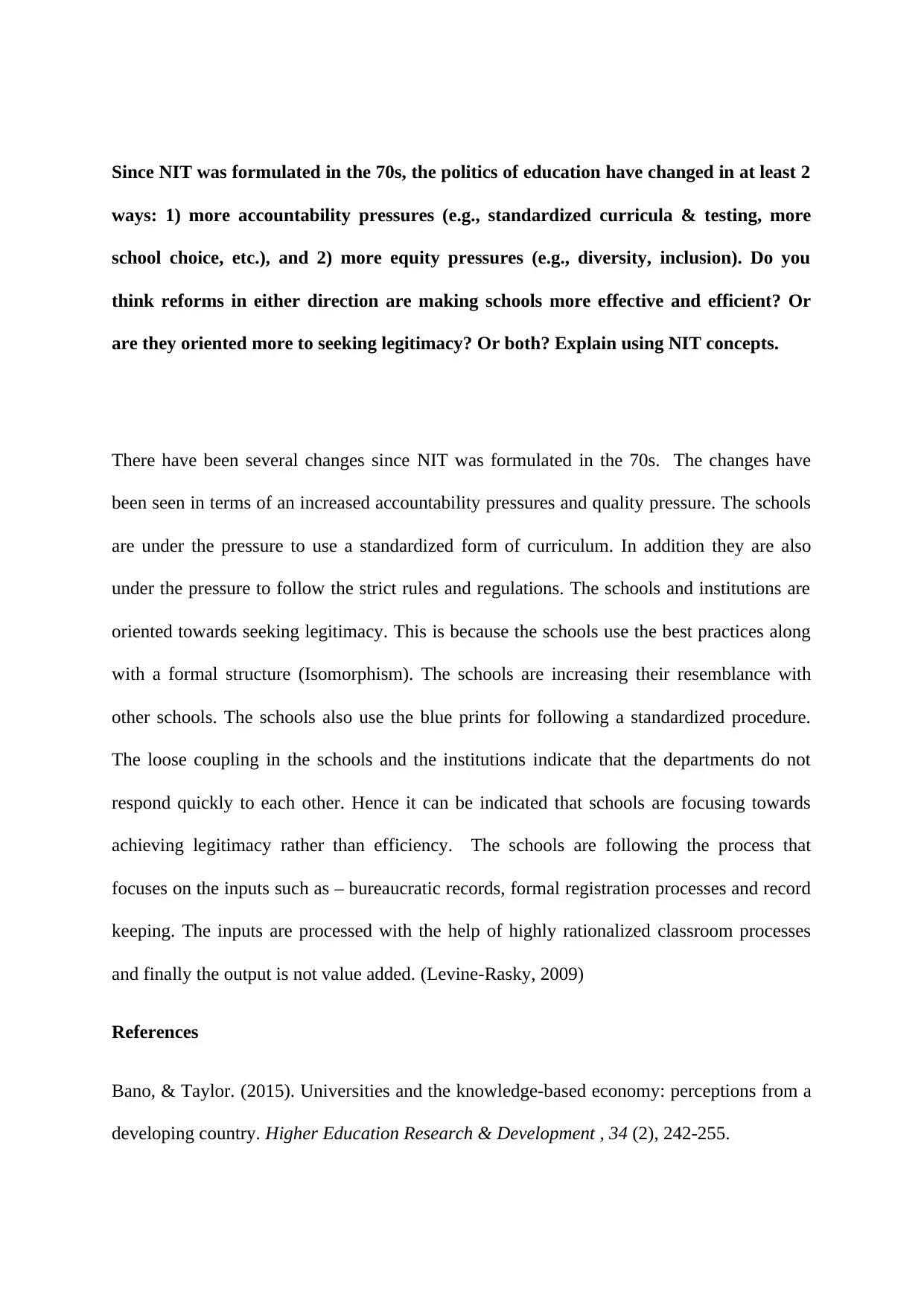
Since NIT was formulated in the 70s, the politics of education have changed in at least 2
ways: 1) more accountability pressures (e.g., standardized curricula & testing, more
school choice, etc.), and 2) more equity pressures (e.g., diversity, inclusion). Do you
think reforms in either direction are making schools more effective and efficient? Or
are they oriented more to seeking legitimacy? Or both? Explain using NIT concepts.
There have been several changes since NIT was formulated in the 70s. The changes have
been seen in terms of an increased accountability pressures and quality pressure. The schools
are under the pressure to use a standardized form of curriculum. In addition they are also
under the pressure to follow the strict rules and regulations. The schools and institutions are
oriented towards seeking legitimacy. This is because the schools use the best practices along
with a formal structure (Isomorphism). The schools are increasing their resemblance with
other schools. The schools also use the blue prints for following a standardized procedure.
The loose coupling in the schools and the institutions indicate that the departments do not
respond quickly to each other. Hence it can be indicated that schools are focusing towards
achieving legitimacy rather than efficiency. The schools are following the process that
focuses on the inputs such as – bureaucratic records, formal registration processes and record
keeping. The inputs are processed with the help of highly rationalized classroom processes
and finally the output is not value added. (Levine-Rasky, 2009)
References
Bano, & Taylor. (2015). Universities and the knowledge-based economy: perceptions from a
developing country. Higher Education Research & Development , 34 (2), 242-255.
ways: 1) more accountability pressures (e.g., standardized curricula & testing, more
school choice, etc.), and 2) more equity pressures (e.g., diversity, inclusion). Do you
think reforms in either direction are making schools more effective and efficient? Or
are they oriented more to seeking legitimacy? Or both? Explain using NIT concepts.
There have been several changes since NIT was formulated in the 70s. The changes have
been seen in terms of an increased accountability pressures and quality pressure. The schools
are under the pressure to use a standardized form of curriculum. In addition they are also
under the pressure to follow the strict rules and regulations. The schools and institutions are
oriented towards seeking legitimacy. This is because the schools use the best practices along
with a formal structure (Isomorphism). The schools are increasing their resemblance with
other schools. The schools also use the blue prints for following a standardized procedure.
The loose coupling in the schools and the institutions indicate that the departments do not
respond quickly to each other. Hence it can be indicated that schools are focusing towards
achieving legitimacy rather than efficiency. The schools are following the process that
focuses on the inputs such as – bureaucratic records, formal registration processes and record
keeping. The inputs are processed with the help of highly rationalized classroom processes
and finally the output is not value added. (Levine-Rasky, 2009)
References
Bano, & Taylor. (2015). Universities and the knowledge-based economy: perceptions from a
developing country. Higher Education Research & Development , 34 (2), 242-255.
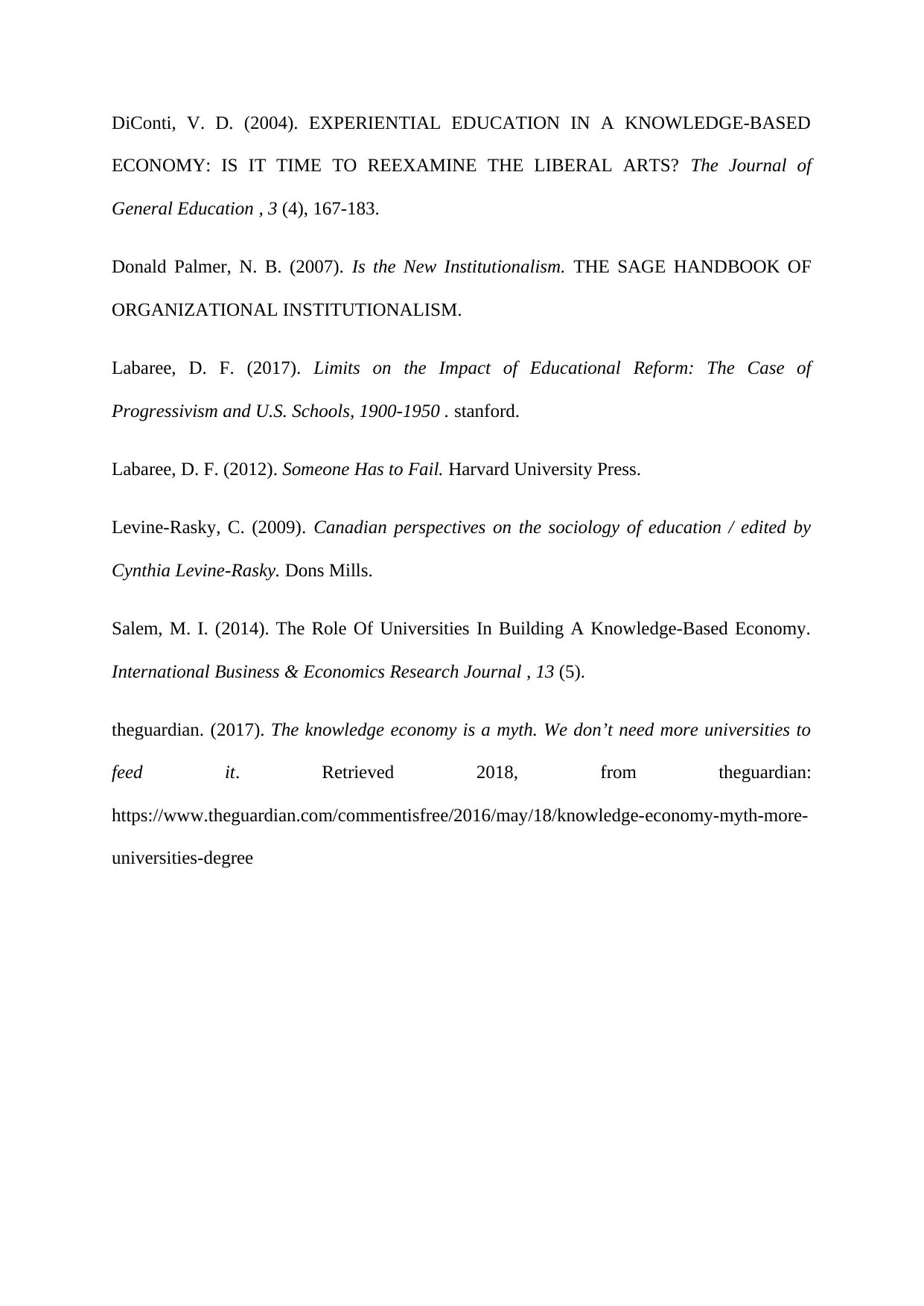
DiConti, V. D. (2004). EXPERIENTIAL EDUCATION IN A KNOWLEDGE-BASED
ECONOMY: IS IT TIME TO REEXAMINE THE LIBERAL ARTS? The Journal of
General Education , 3 (4), 167-183.
Donald Palmer, N. B. (2007). Is the New Institutionalism. THE SAGE HANDBOOK OF
ORGANIZATIONAL INSTITUTIONALISM.
Labaree, D. F. (2017). Limits on the Impact of Educational Reform: The Case of
Progressivism and U.S. Schools, 1900-1950 . stanford.
Labaree, D. F. (2012). Someone Has to Fail. Harvard University Press.
Levine-Rasky, C. (2009). Canadian perspectives on the sociology of education / edited by
Cynthia Levine-Rasky. Dons Mills.
Salem, M. I. (2014). The Role Of Universities In Building A Knowledge-Based Economy.
International Business & Economics Research Journal , 13 (5).
theguardian. (2017). The knowledge economy is a myth. We don’t need more universities to
feed it. Retrieved 2018, from theguardian:
https://www.theguardian.com/commentisfree/2016/may/18/knowledge-economy-myth-more-
universities-degree
ECONOMY: IS IT TIME TO REEXAMINE THE LIBERAL ARTS? The Journal of
General Education , 3 (4), 167-183.
Donald Palmer, N. B. (2007). Is the New Institutionalism. THE SAGE HANDBOOK OF
ORGANIZATIONAL INSTITUTIONALISM.
Labaree, D. F. (2017). Limits on the Impact of Educational Reform: The Case of
Progressivism and U.S. Schools, 1900-1950 . stanford.
Labaree, D. F. (2012). Someone Has to Fail. Harvard University Press.
Levine-Rasky, C. (2009). Canadian perspectives on the sociology of education / edited by
Cynthia Levine-Rasky. Dons Mills.
Salem, M. I. (2014). The Role Of Universities In Building A Knowledge-Based Economy.
International Business & Economics Research Journal , 13 (5).
theguardian. (2017). The knowledge economy is a myth. We don’t need more universities to
feed it. Retrieved 2018, from theguardian:
https://www.theguardian.com/commentisfree/2016/may/18/knowledge-economy-myth-more-
universities-degree
⊘ This is a preview!⊘
Do you want full access?
Subscribe today to unlock all pages.

Trusted by 1+ million students worldwide
1 out of 6
Your All-in-One AI-Powered Toolkit for Academic Success.
+13062052269
info@desklib.com
Available 24*7 on WhatsApp / Email
![[object Object]](/_next/static/media/star-bottom.7253800d.svg)
Unlock your academic potential
Copyright © 2020–2025 A2Z Services. All Rights Reserved. Developed and managed by ZUCOL.
